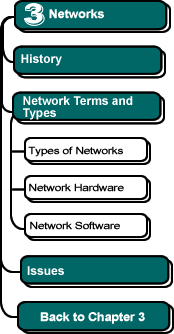
|
Network Cards and Hubs
 One
of the most common ways to give a computer the capability to accept a
network cable connection is by adding a network interface card,
or NIC.
One
of the most common ways to give a computer the capability to accept a
network cable connection is by adding a network interface card,
or NIC.
Some computers come with a network interface built right into the motherboard and do not require the addition of a card.
Again, you are likely to hear a network interface card referred to as an ethernet card. When you hear "ethernet," think "network."
 Network
connections can be shared through the use of a hub. A
hub has multiple ports. Each computer wishing to share a connection simply
runs a cable from the network port on the computer (e.g., on the network
card) to an open port on the hub.
Network
connections can be shared through the use of a hub. A
hub has multiple ports. Each computer wishing to share a connection simply
runs a cable from the network port on the computer (e.g., on the network
card) to an open port on the hub.
It is important to note, however, that this form of sharing is possible because when the hub receives a packet from the network, the hub sends a copy of that packet to all of the ports in the hub. Thus, any packets meant for one of the computers connected to the hub get sent to all of the computers connected to the hub. If a dishonest user of one of the connected computers runs a packet sniffer (software for examining Internet packets as they travel by), he or she will be able to see information intended for other users.
On the other hand, a switching hub—usually called a switch—reads the destination address of each packet and sends it only to the computer connected to the correct port.
Sharing a network connection? You might want to know if you're sharing via a hub or a switch!
![]()
![]()
This chapter was written by Jeff Nyhoff and Joel Adams. Copy editing by
Nancy Zylstra
©2005 Calvin University (formerly Calvin College), All Rights Reserved
If you encounter technical errors, contact computing@calvin.edu.
